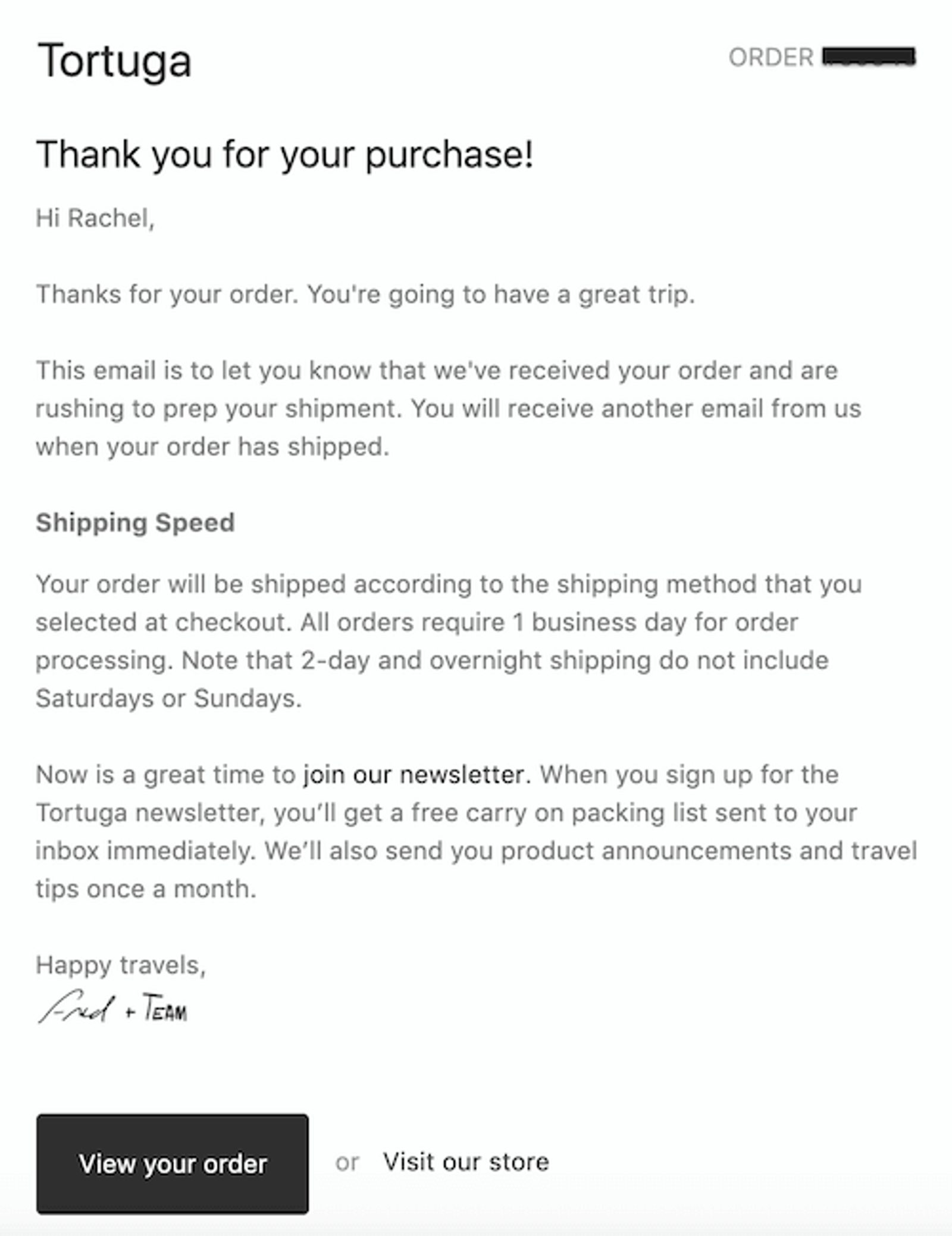Transactional emails are real-time, automated emails sent to users after a certain action takes place on a platform, app, or website.
These are also called triggered emails because an event or trigger has to take place for the email to be sent.
Despite the name, not all transactional emails have to do with money or purchases. Transactional emails can include:
- Purchase receipts
- Shipping confirmations
- Email verifications
- Account updates
- Password resets
- Social media notifications
- Event notifications
- And much more!
Most people don’t think much about these types of emails. As customers, we take transactional emails for granted. But transactional emails are an important part of running an ecommerce store, software company, or any other online business.
Transactional emails vs. marketing emails: What’s the difference?
The three main differences between transactional emails and marketing emails are:
- Marketing emails have to be opted into. Transactional emails do not.
- Marketing emails aren’t always triggered by an action within the platform. All transactional emails are.
- Marketing emails (should) come from a different server and provider than transactional emails
Should you send transactional emails through your marketing automation platform?
You should not send transactional emails through your marketing automation platform.
Customers should always be able to unsubscribe from marketing emails. It’s the law!
But you probably don’t need to let your customers unsubscribe from transactional emails.
If customers unsubscribe from transactional emails, they'll miss out on important account updates, purchase confirmations, and other notifications.
ActiveCampaign is a marketing automation platform. We don’t have a dedicated transactional email server. Sending your marketing emails through ActiveCampaign is awesome. But your transactional emails (like order confirmations and receipts) should come from another platform.
(Note – it's still a good practice to send an additional automated follow-up email, which you can do in ActiveCampaign).

This is you using a transactional email provider. Don’t let them unsubscribe! (via GIPHY)
6 common types of transactional emails
Here are the 6 most common types of triggered transactional emails:
- Purchase receipt and order confirmation emails
- Account creation and welcome emails
- Password reset emails
- Email validation emails
- Account update
- Event-driven notifications
1. Purchase receipt and order confirmation emails
When a customer places an order through your online store, it triggers an order confirmation email. These emails usually include information about:
- Items purchased
- Payment method used
- Shipping address
- Expected delivery date
Many ecommerce stores send additional shipping confirmation emails once an order is on its way.

This email also includes an order summary below this note. Tortuga does a great job of giving shipping information and letting me know what to expect next.
Plus, they throw in a subtle marketing CTA — “join our newsletter” — with the promise of exclusive content (a packing list) relevant to their audience (travelers).
2. Account creation and welcome emails
Account creation emails are triggered when a customer creates a new account on your website or app.
These emails should make customers feel great about the account they just created (and inspire them to use it). Make sure you include any next steps you want your customers to take.

This cute welcome email introduces the Duolingo mascot and shares two tips for making the most of my new account.
3. Password reset emails
Everyone forgets passwords sometimes; to err is human. Make it super simple for your customers to reset their password — too many clicks or forms and a user might give up and go elsewhere.

Simple and no frills — just like budget airlines. Spirit’s password reset email for their Free Spirit loyalty program lays out how to reset my password and lets me go do it in just a couple of clicks.
4. Email validation emails
Also called email verification emails or email confirmation emails, email validation emails make sure you’re emailing who you think you’re emailing. No spam or fake accounts allowed!
You can use email verification tools to make your work easier. Requiring email validation helps keep your deliverability high — you only send emails to people who want them, not fake mailboxes, spam traps, or users who’ll send you straight to spam.

This email from Lyft tells me: (1) Why they need to verify my email, (2) What I should do if this is my Lyft account, and (3) What I should do if this isn’t my Lyft account.
5. Account update
When a user updates their account info, a quick confirmation email lets them know you (or your system) got it. The information updated can include:
- Contact information
- Payment method
- Subscription or plan
- Password
- User preferences

This simple and straightforward email from Delta confirms that I updated my account information. (Can you tell from my examples that I’ve been planning a trip?)
6. Event-driven notifications
Event-driven notifications are triggered whenever something happens in your software product, online platform, or mobile app and you want to let your customers know. Notifications can include:
- Security alerts
- Social media notifications
- Event RSVPs
- And more!
Customers can usually choose which types of event-driven email notifications they want to receive. Make sure to include next steps in these emails, so your customers know what to do with the info you share.

Based on my LinkedIn settings, I get emails whenever I have a new connection. My coworker accepted my connection request (thanks Perry!), so LinkedIn notifies me and encourages me to message her.
How to send transactional emails
So, you know you don’t want to use your marketing automation platform to send transactional emails. You don’t want your customers to be able to unsubscribe. You know what not to do, but then how do you send transactional emails?
With a transactional email service, such as:
- Postmark
- SendGrid
- Mailgun
- Amazon SES
- And many more
What is a transactional email service?
A transactional email service is an email provider built specifically for sending transactional emails. These email platforms have dedicated servers for transactional emails to guarantee higher deliverability.
Many transactional email platforms feature drag-and-drop editors to make it easy to build transactional email templates, even if you don’t know how to code or design emails.
Some providers also offer:
- Email deliverability features
- Reputation monitoring
- Dedicated IP addresses
- Reporting and analytics tools
- Open rate, click-through rate, and bounce rate reports
- Unsubscribe tracking
SMTP vs. API
Transactional email services use SMTP relays or REST APIs to send your emails. Looks like alphabet soup, right? Let’s break it down:
SMTP stands for Simple Mail Transfer Protocol. SMTP acts as a post office that passes your mail along to the recipient. When looking into transactional email services, you might see people talk about SMTP integrations or SMTP relay.
Relaying is the process of transferring an email from one server to another. SMTP relay routes your bulk transactional emails through a trusted 3rd party to your customer.
Why choose SMTP? Cloud-based email providers don’t always have the deliverability or bandwidth to send so many real-time emails without getting marked as spam. SMTP is built to make sure your transactional emails get to your recipient’s inbox.
API stands for Application Programming Interface. This is a less popular and reliable option for sending triggered emails. If you can’t or don’t want to use a local mail server and SMTP, you would use an email API. It’s also important to protect your APIs effectively, as they can be vulnerable to exploitation by malicious third parties if they are not robustly defended from a range of common threats.
You need to use an API instead of SMTP if…
- Your ISP blocks all outgoing mail ports
- Your site connects super slowly to your transactional email provider, meaning each client-server interaction takes a long time
- You don’t have full control your site code or application, so you can’t install or configure SMTP
A few transactional email tips and tricks
Just like their marketing campaign counterparts, good transactional emails can increase customer loyalty and customer retention.
Before you go forth and create beautiful, effective transactional emails, here are some tips:
- Make sure your email is responsive. Test in on multiple devices and different mail apps.
- Test and review your transactional emails often! The set-it-and-forget-it mentality won’t work here.
- A/B testing isn’t just for marketing emails. Test different subject lines, CTAs, and designs in your transactional emails. Just make sure to only change up one variable at a time so you can narrow down what works (and what doesn’t).
- Keep an eye on deliverability. We talk about this a lot when it comes to email marketing campaigns, but it matters for triggered emails, too. You really don’t want your password reset or order confirmation emails going to spam. Good deliverability also keeps your open rates high.
- That’s why choosing a reputable transactional email service is so important — no need to reinvent the wheel with deliverability and risk not being able to get your customers the info they need!
- When in doubt, less is more — think critically about the information you include. You can include limited marketing language and links in transactional emails, but first and foremost they should provide important information. (Plus, the more marketing language you use, the bigger risk to your deliverability and sender reputation.)
Now you’re ready to get out there and set up some triggered emails. Good luck, and may the deliverability force be with you!







